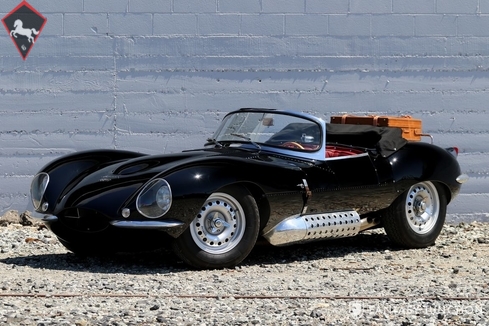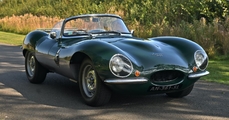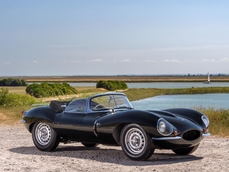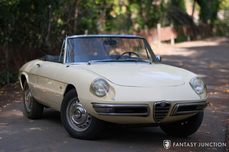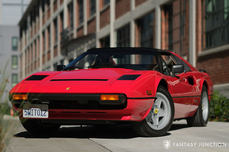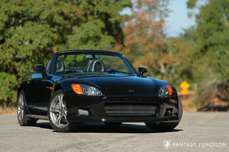Jaguar XKSS 4.2 Litre DOHC Inline 6-Cylinder 1957
General description :
1957 Jaguar XKSS Recreation by Lynx
s/n 1E30084
Black with Red Leather Interior
Among the most beautiful automobiles ever conceived and crafted, the Jaguar XKSS is today regarded as one of the most desirable sportscars of the modern era. First constructed in 1957, the Jaguar factory converted twenty-five remaining racing D-Types (then under construction) into road-going configuration. This fortuitous conversion, a requirement to compete in the North American SCCA racing series, proved to be a delight for motoring enthusiasts all over the world. By adding a full-width glass windscreen, bumpers, passenger door, and a host of other detailed finishing elements, these twenty-five cars would serve as ambassadors to Jaguar’s largest and growing export market – North America. Sadly, a devastating fire at the factory destroyed the XKSS production line, tragically eviscerating nine of these exceptional factory cars. Only sixteen of the original cars survived. Over the years, particularly as values for the remaining sixteen cars have escalated into the millions, much lore has transpired regarding the nine vanquished cars, adding further to the mystique of these beautiful Jaguars. Most recently, Jaguar Cars has announced they will build the phantom nine XKSS cars as a “continuation” XKSS series, faithfully based on the original specifications in tribute to those lost in the fire. Even though these cars are still under construction, all of the nine cars have already sold for well over a million dollars each.
In 1968 a group of intrepid Sussex based motorsports enthusiasts established Lynx Engineering to tune and repair specialized British race cars. By 1972 the team cultivated the notion that legendary British sports cars could be fitting subjects for revival and began building accurate recreations of the Jaguar D-Type, C-Type, E-Type Lightweight, and the iconic XKSS. With many of the craftsmen from the original period still alive and eager to apply their artistry to such projects, Lynx was able to employ methods and construction techniques identical to the original designs, with results that accurately mirrored the original examples. Artisans worked to not only achieve the beauty and excellence in the recreations, but also worked concurrently on restoration projects, applying accuracy and technical facility to each of their Lynx offerings. The results of these combined talents have yielded remarkable cars that truly honor these legends in both beauty and performance.
This particular XKSS Recreation by Lynx was specifically constructed in 2016 and completed in 2017 on special order for the North American Lynx Representative, the first and only owner of this stunning alloy-bodied hand crafted sportscar. Recorded as the thirteenth of sixteen constructed to date, the handmade aluminum tub was fabricated to exacting standards and dimensions. Construction included a new handmade monocoque tail section and bonnet in 16 swg aluminum as well as a left-hand drive monocoque with an extended footwell and re-positioned seat back panels to allow for additional legroom. A new uprated front chassis frame was constructed using Reynolds tubing and original specification XKSS hood, bumpers, and luggage rack were installed. The windscreen frame was formed using 16 swg aluminum per the original XKSS with an original specification windscreen specially molded using laminated safety glass from Lynx tooling.
The handmade construction of this Lynx XKSS was combined with the majority of components from 1964 Jaguar XKE #30084, purchased by the owner for use in fabrication. Both a build plate and corresponding body number plate are present and riveted to the appropriate sections of the car. Utilizing several major components from the donor XKE (used as well for the registration and title on the car), the twin cam 4.2 liter Jaguar engine was comprehensively refurbished including the head which was aluminum gas flowed and blue printed with enlarged ports, and fitted with a specialized Lynx Weber gas flowed intake manifold and triple Weber 45DCOE carburetors. Internally, the engine was rebuilt with Lynx competition steel rods, a lightened and balanced forged crankshaft, and Lynx semi-competition camshafts. The exhaust manifolds were specially constructed for LHD as was the hand built stainless steel exhaust system. A high efficiency aluminum radiator, low profile cooling fan, and Lynx D-Type aluminum header tank were installed to meet the cooling needs. A Getrag 5-speed gear box was installed featuring a 9.5” clutch and lightened flywheel. Utilizing the front and rear suspension from the XKE, Lynx upgrades to dampers, bushings, and improved adjustable torsion bars were just a few of the many suspension improvements to enhance handling and durability. A competition modified and rebuilt Salisbury power-lock differential was installed with rear axle ratio 3.07:1.
Among the many additional features included during the build, exceptional care was given to the safety and security of the brakes, fuel system, and electrical components. All brake lines were constructed with Kunifer tubing and braided Aeroquip flexible lines using multi-pot Lynx front calipers and XJS solid disc brakes. A 30-gallon aluminum fuel tank was installed with an electronic Hyco fuel pump and braided fuel lines. Electronic ignition and a high capacity competition alternator and a lightweight starter were also installed. Original specification 16” x 6” alloy Dunlop wheels with pegdrive hubs and chrome plated knockoffs were shod with Vredestein Sprint Classic radial tires. The interior was finished with a satin black dashboard and McQueen cubby box, seatbelts, McQueen specification XKSS seat cushions, and a specially built original specification D-Type quick release steering wheel. Other notable items include removable side curtains, a hidden electrical cut-off switch, Lynx dry sump lookalike system, a Sonnenland top, Lynx carburetor trumpets, polished aluminum bumpers, Monza fuel cap, rear light plinths, Halogen H4 headlamps, and headlamp cover trim.
During the year-long fabrication from 2016-2017, the owner was fortunate to be able to document the construction featuring hundreds of detailed photographs showing multiple components being assembled and prepared for installation. These photos not only document the fastidious Lynx workmanship and attention to detail, they visually catalog multiple aspects of the complex build and precise specifications. After the car was completed and delivered to the current owner, he showed the car in several events frequently taking home awards of distinction including 1st place at the 2017 Jaguar Clubs of North America Championship SE Regional Concours and 1st place at the 2017 Jaguar Clubs of North America “International Jaguar Festival”.
Exemplary in every aspect, this Lynx XKSS is stunningly finished with smooth and glossy black Glasurit paint beautifully applied to the hand formed alloy body panels. The exquisite form and superb craftsmanship are all the more impressive when seen in gorgeous black reflections. The fit and finish of all surfaces and openings is composed to exacting standards. Virtually all bright work and polished accessories are lovingly presented, accenting against the fluid black surfaces of the sensuous fender lines. The pouncing stance is perfectly composed resting eagerly on the alloy D-Type Dunlop wheels and correctly specified Vredestain tires. The look and feel of the powerful stainless side exhaust against the curvaceous body creates a brilliant juxtaposition of power and grace. Wonderful period correct details include leather bonnet latches, lever arm locks, hood script lettering, Monza fuel filler, and aircraft inspired riveted body panels. Even the hand-crafted custom luggage case is constructed with vintage charm and elegance.
The interior is handsomely tailored with attention to detail consistent with the original XKSS, but allowing for safety and ease of use under modern road conditions. Here again, the use of aircraft construction methods in the raw aluminum monocoque are revealed throughout the riveted floor and welded lap fold construction of the interior. The red leather seats are formed to allow for slightly more driver and passenger space, working well with the larger dimension foot box area and slightly reduced diameter of the wood and aluminum steering wheel. Black dial Smith instruments are accurately arrayed with the controls, switches, and key features easily at hand. Additional handsome polished aluminum and plated touches appear throughout the interior including on the switchgear, hand brake and various trim throughout the aviation-inspired cockpit. Accessing the rear spare tire compartment, the hand formed tailgate drops open revealing a matching spare wheel captured by a proper leather strap, fixed into position beneath the accessory rack. Virtually every aspect of the construction is honest, authentic, and reflective of the original intent and design Jaguar envisioned for these rare road cars.
Under the hood resides a gloriously finished 4.2 Liter Jaguar E-Type engine, enhanced by a polished twin cam head and triple Weber carburetors featuring a specially constructed Lynx polished intake manifold, Weber carburetors, and polished trumpets. The engine compartment is fitted with a polished aluminum water tank, handsomely blued stainless-steel exhaust tubes, handmade riveted bulkhead construction, and other delightful mechanical details, completing the look of this very capable and stunningly equipped XKSS. The underside of the car also features correctly finished components, superlative construction, mechanical integrity, and minimal evidence of use since construction was completed only two years ago.
With the twist of the key and a press on the starter button, the mighty twin-cam ignites to life and slowly settles into a smooth but deeply engaging idle, hinting at the race-inspired origins of these iconic Jaguars. Driving position is well laid out and surprisingly spacious owing to the additional occupant space designed into construction for this specific car. And while a bit of learning is required settling into driving position, once nestled inside, you instantly become unified with the car. Operating temperatures come up quickly, all instruments indicate properly, and, with a blip of the throttle you are quickly on the road. Shifting is easy through the 5-speed synchromesh transmission with power coming on progressively, yet still offering sharp bursts of acceleration when commanded with authority, due in part to the semi-competition cams and triple Webers. Cornering is wonderful either at highway speeds or while escaping to lush mountain roads where the independent suspension and fantastic brakes can truly show their capability. Overall the ride engineering and composure are impressive and engaging, especially when considering the era of conception. Included with the car are several documents supporting the build and components, a copy of the original title for the XKE donor car, and reference photos of the factory construction.
This phenomenal XKSS is ready to deliver undeniable pride of ownership and superlative driving enjoyment at a fraction of the cost of the original. Wonderfully constructed by a cadre of world renown fabricators to exacting standards. This beautifully prepared Lynx XKSS honors the lineage of these multi-million dollar cars not only for their profound beauty and success on legendary racetracks, but for the stunning and innovative engineering that continues to inspire enthusiasts all over the world.
https://fantasyjunction.com/inventory/1957-jaguar-xkss-recreation-by-lynx/overview
1957 Jaguar XKSS 4.2 Litre DOHC Inline 6-Cylinder is listed sold on ClassicDigest in Emeryville by Fantasy Junction for Not priced.
Car Facts
Car type : Car Make : Jaguar Model : XKSS Model Version : 4.2 Litre DOHC Inline 6-Cylinder Engine size : 4.2 Model Year : 1957 Location : Emeryville Vehicle Registration : Normal
Sold
Seller Information
Sold
People who viewed this Jaguar XKSS also viewed similar Jaguar listed at ClassicDigest
Other cars listed for sale by this dealer
About Jaguar
Ah, the story of Jaguar, from its early days as the SS Cars Ltd. to its pinnacle with the D-type, and the street-going evolution in the form of the iconic E-type. There's something quintessentially British about this tale, and I'll narrate it as a British journalist might.In the Beginnings:
Our journey into the world of Jaguar begins in the 1930s, when a company known as SS Cars Ltd. emerged. Despite the unfortunate coincidence of their initials with the rising political tensions in Europe, they started producing stylish and performance-oriented cars. The SS 100, introduced in 1936, was a symbol of elegance and speed, setting the stage for what would become Jaguar.
The Birth of Jaguar:
As the shadows of World War II loomed, SS Cars Ltd. wisely decided to disassociate themselves from the SS initials. Thus, in 1945, they officially became Jaguar Cars Ltd., a name that would soon be synonymous with British luxury and performance.
The XK Series:
Jaguar's post-war era brought us the XK 120, a true sensation in 1948. With its sleek design and a powerful 3.4-liter inline-six engine, it became the world's fastest production car. The XK 120 was the blueprint for what lay ahead – Jaguars that blended style with speed in a uniquely British fashion.
The D-type Dominance:
Then came the D-type, a true racing legend. Introduced in 1954, it won Le Mans three times in the 1950s, showcasing Jaguar's engineering prowess. With its innovative monocoque construction and the iconic fin at the back, the D-type was the apex of Jaguar's motorsport success.
The E-type Emergence:
But the true turning point arrived in 1961 with the introduction of the E-type, often described by Enzo Ferrari as "the most beautiful car ever made." Its long bonnet, curvaceous body, and a 3.8-liter engine delivering exhilarating performance made it an instant classic. The E-type was not just a car; it was a work of art on wheels, and it could hit 150 mph on the road.
Street and Racing Success:
The E-type's beauty was matched by its capability on the track. The lightweight E-types were particularly successful in various racing events, cementing Jaguar's reputation as a force to be reckoned with in motorsport.
The Age of Refinement:
As we delve deeper into the Jaguar story, we find that the 1950s and 1960s were an age of refinement and expansion. Alongside the magnificent D-type and the E-type's iconic emergence, Jaguar introduced models that further solidified its reputation for luxury and performance.
The MK2:
In the late 1950s, Jaguar unveiled the MK2, a sports sedan that combined elegance with power. This sleek four-door saloon was a favorite of bank robbers and law enforcement alike, thanks to its exceptional speed and handling. The MK2 was a symbol of Jaguar's ability to blend sophistication with performance and had a successful racing career as well.
The XJ6:
Fast forward to 1968, and Jaguar launched a car that would define luxury saloons for decades to come – the XJ6. It was a masterpiece of engineering and design, featuring a smooth inline-six engine, independent rear suspension, and a spacious, beautifully appointed interior. The XJ6 was a symbol of British elegance and provided a ride so smooth that it seemed to glide over the road. It became the flagship model for Jaguar and set the standard for luxury saloons, showcasing a level of refinement that left competitors in awe.
The Blend of Classic and Modern:
While the MK2 and XJ6 represented the evolution of Jaguar's saloon cars, they maintained the brand's commitment to performance and luxury. These cars didn't just belong on the racetrack; they were equally at home cruising down the grand boulevards or gliding through the English countryside.
The Challenges of Change:
However, as the 1970s arrived, Jaguar, like many British automakers, faced financial challenges and changes in ownership. The British Leyland era brought both opportunities and struggles, as the brand navigated through various mergers and transitions.
Nevertheless, the legacy of the MK2 and XJ6, along with the D-type and E-type, continues to define Jaguar as a manufacturer that combines timeless elegance with a spirit of performance. These classic models, whether driven on winding roads or parked as collectors' treasures, serve as a testament to Jaguar's enduring presence in the world of automotive excellence.
The Jaguar story, from its early days as SS Cars Ltd. to the creation of automotive icons like the E-type, MK2, and XJ6, is a journey that reflects the very essence of British motoring – a blend of luxury, power, and style that continues to captivate enthusiasts and connoisseurs alike.
